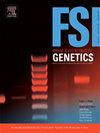A preliminary report on the exploration of salivary bacterial diversity by the multiplex SNaPshot assay
Abstract
Salivary bacterial community composition is associated with the host’s internal and environmental factors, which have potential applications in forensic practice. The 16S rRNA gene sequencing is the most commonly used strategy for detecting salivary bacterial diversity; however, its platforms are not compatible with capillary electrophoresis (CE) platforms commonly used for forensic applications. Therefore, we attempted to detect the salivary bacterial diversity using a single nucleotide polymorphism (SNP) assay. Salivary bacterial diversity varies among diverse geographic locations, making it a potential supplementary biomarker for forensic geographic sourcing. To evaluate the performance of the multiplex SNaPshot assay, saliva samples from three geographic locations in China were analyzed using the multiplex SNaPshot assay and 16S rRNA gene sequencing. We screened SNPs from two high-relative-abundance salivary genera (Streptococcus and Veillonella) to construct a multiplex SNaPshot system that can be used on the CE platform. The stability and sensitivity of the multiplex SNaPshot system were also tested. A random forest classification model was used to classify samples from different regions to explore the ability of salivary bacteria to discriminate between geographic sources. Six bacterial SNPs were screened and a multiplex SNaPshot system was constructed. The stability results showed that the typing of salivary stains that were placed indoors for different days was not affected in this study. Two-thirds of mocked salivary stain samples showed more than 90% of typing results obtained for salivary stain samples with an input of 0.1 µl saliva. The results of principal coordinate analysis based on salivary bacterial diversity showed significant differences between samples from the three different geographic locations. The accuracy of the random forest classification was 66.67% based on the multiplex SNaPshot assay and 83.33% based on the 16S rRNA gene sequencing. In conclusion, this is the first attempt to detect salivary bacterial diversity using a multiplex SNaPshot bacterial SNP assay. The geographic difference in human salivary bacterial community composition was significant, as revealed by the multiplex SNaPshot assay; however, its performance in discriminating geographic sources was lower than that of 16S rRNA gene sequencing. This strategy based on bacterial SNP loci may favor the detection of human bacterial diversity in common forensic laboratories but requires further exploration in larger sample sizes and more bacterial SNP loci.

 求助内容:
求助内容: 应助结果提醒方式:
应助结果提醒方式:


